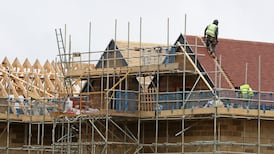The performance of the Irish economy has been phenomenal in recent years. The most remarkable change has been in job creation. The much lauded US "Jobs Machine" has been greatly surpassed by the Irish performance in recent years.
Between 1987 and 2000, the increase in employment will be a staggering 45 per cent of non-agricultural jobs. For every 10 jobs in the Republic in 1987, there will almost be an extra five jobs next year and there has also been an upgrading of jobs.
The US has been seen as the miracle job-producing economy, and proponents of deregulation of the labour market cite it as the model to follow. At its crudest, their philosophy holds that the jobs arise because the choice for the unemployed is "work or starve". The Republic performance sets out a challenge to this approach where several factors have led to the superb economic performance, including the national partnership between unions, employers and government. (See table right).
Even between 1986 and 1996, the Republic had already created more non-agricultural jobs than the US, according to the OECD. Total employment rose by 26 per cent in the Republic, compared to only 7 per cent for the EU or even 15 per cent for the US.
This increase has been almost all in the private sector, as public sector employment growth has been negligible. And the trend has continued with the Republic's rate being much higher than the US since 1994. As the table shows, 1990 was a very good year for jobs, but it was not really until 1994 that the jobs machine really took off, with consistent and substantial annual job creation each year since. Between 1994 and 2000 almost 400,000 extra non-agricultural jobs will have been created in just seven years - a staggering performance, particularly when contrasted to zero jobs in the first 70 years since Independence. It is an increase of one-third in seven years or an average increase of 56,300 each year.
Contrary to some views, most of the jobs have not been low-skill, nor have many been forced to accept part-time work when they would prefer to work full time. What kind of jobs have they been?
Some believe that they are mainly hamburger flippers, but the real picture is surprisingly good, except for those who are unskilled. While a growing proportion are part time - the sector more than doubled from less than 7 per cent of total employment in 1983 to more than 17 per cent in 1998, but the incidence of underemployment (those who would like a full-time job) fell substantially and it appears that most of those working part time wish to do so. Nonetheless, there has also been a growth in low-paying jobs.
The numbers in agriculture continued their downward fall, from 17 per cent in 1983 to 8.4 per cent in 1999. Manufacturing had severe job losses in the 1980s but, against the international trend of decline in manufacturing jobs, the Republic has enjoyed a substantial increase of around 3 per cent growth a year in the 1990s.
Yet the biggest increase in jobs was in services and there has been a "significant up-grading of the occupational structure", according to Mr Phillip O'Connell of the ESRI.
"Over the 1981-1997 period the strongest growth took place among professional, technical and managerial occupations, but also in clerical and sales occupations" he found in a paper presented to the International Labour Organisation last year.
However, there had been a fall in the number of semi-skilled and unskilled manual jobs, though this may have changed since with the emergence of the tight labour market.
Within services, public sector employment, including the civil service, defence and State companies, have barely grown in the 1990s, having also been held still in the 1980s. The trend towards upgrading of jobs in the labour market is more than a change from manual to non-manual jobs. It is following a similar pattern in other countries. New jobs require qualifications, skills and flexibility which is considerably different than those required in traditional employment.
Women's participation in work increased dramatically, though from a low base of 32 per cent in 1986 to 44 per cent by early 1999. In contrast, men's participation has moved in the opposite direction, falling from more than 76 per cent in 1981 to 69 per cent. The overall participation rate rose from 53 per cent in the 1980s to 57 per cent in 1999. By the end of 1999 labour shortages are evident in many areas. There has also been a substantial rise in the numbers participating in education - up from 200,000 in 1981 to 363,000 in 1999.
There appears to be little change in self-employment, but when agriculture - which has been in decline - is excluded, there has been substantial growth, with numbers up from 90,000 in 1981 to 150,000 in 1996.
Unemployment has fallen substantially from a peak of almost 18 per cent in 1987 to just 5.8 per cent today. There is still a core of long-term unemployment of 44,000, many of whom are in clusters and have poor education and a lack of skills which can and should be addressed by the State.
Never has there been such a good period of job creation. The historic failure of two centuries mass emigration and unemployment has finally been reversed.
Paul Sweeney is the author of The Celtic Tiger: Ireland's Continuing Economic Miracle to be published on October 18th by Oaktree Press. The table is sourced from the book.









